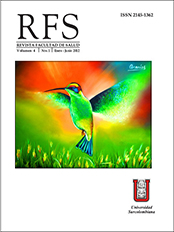Stage distribution of breast cancer at University Hospital in Neiva, 2011
##plugins.themes.bootstrap3.article.main##
Early diagnosis of breast cancer represents 90% survival when treated in early stages and 20% survival when diagnosed in late stages. It was performed a cross-sectional study with 123 patients suffering from breast cancer confirmed by histopathology. The aim is to identify the clinical stage of breast cancer at the time of diagnosis in users from Oncology Unit at Hospital Universitario Hernando Moncaleano Perdomo of Neiva in 2011; information was collected by reviewing patients’ medical history with the help of a questionnaire filled out by the researchers. Results. 76.29% of patients were diagnosed in locally advanced stage (IIB - IIIB), being the most frequent stage IIB (32.56%); 90.37% of cases are infiltrating ductal type. Patients are diagnosed when they are at an average age of 51; there was a relationship between positive estrogen receptors over 50 years of age and progesterone receptors (P=0.05, X2= 73.45). There was a Spearman correlation between cancer stage and the period when surgery is performed on the patient, obtaining a positive coefficient “low” of 0.275 (p = 0.008) IC 95% (0.08 - 0.46). Finally, it was found association between social security scheme and stage breast cancer variables and X2 8.05 (P = 0.005). It was concluded that in the Oncology Unit there are 1, 2 times more chances that a patient, belonging to subsidized scheme and / or involved, is in locally advanced stage.
Downloads
##plugins.themes.bootstrap3.article.details##
Parkin DM, Bray F, Ferlay J, Pisani P. Global Cancer Statistics, 2002. CA Cáncer J Clin 2005; 55(2):74-108.
Ministerio de la Protección Social; Protocolo de Manejo del paciente con Cáncer de mama. 20092011; Versión 1, pag. 37-60.
Piñeros M, Sánchez R, Cendales R, et al. Características sociodemográficas, clínicas y de la atención de mujeres con cáncer de mama en Bogotá. Revista Colombiana de Cancerología 2008;12(4):181-190.
Departamento Administrativo Nacional de Encuestas DANE. Defunciones por Grupos de edad y sexo, Según Departamento, Municipio de Residencia y Grupos de Causas de Defunción (Lista de Causas Agrupadas 6/67); 2008.
Angarita F, et al. Presentación inicial de las pacientes con diagnóstico de cáncer de mama en el Centro Javeriano de Oncología, Hospital Universitario San Ignacio. Revista Colombiana de Cancerología. 2010;25:181-190. Availablefrom.
González M, Mariño A. Cáncer de Seno en la Clínica San Pedro Claver de Bogotá. Revista de Salud Pública, 2004;8(2):163-169.
Gutiérrez A, Olaya J, Medina R. Frecuencia de cáncer de seno mediante detección temprana en el Hospital Universitario de Neiva entre el 1 de junio y el 30 de noviembre de 2007. Revista Colombiana de Cancerología. 2009, marzo. [cited 2011 Aug 10]. Available from: http://www. scielo. org.co/scielo.php?script=sci_arttext&pid= S2011-758220090001000 04&lng=en
National Cancer Institute. Lo que usted necesita saber sobre el Cáncer de Seno, pág. 17; http:// www.cancer.gov/espanol/tipos/necesita-saber/seno.pdf; consultado el 12-04-12.
Ferlay J, Bray F, Pisani P, Parkin DM. Globocan. Cáncer Incidence, Mortality and Prevalence Worldwide, Version 2.0, 2002.
Secretaría de Salud, Departamental del Huila. Indicadores Básicos 2010; pág. 38, 39.
Tabassoli FA. Pathology of the breast. 2nd Ed. Amsterdam: Elsevier; 1999.
Instituto Nacional de Cancerología. Recomendaciones para la tamización y la detección temprana del cáncer de mama en Colombia. Bogotá: INC, 2006.
Fraser GE, Shavlik D. Risk factors, lifetime risk, and age atonce of breast cancer. Ann Epidemiol. 1999;7:375-82.
American Cáncer Society. Breast Cáncer Facts and Figures, 1999-2000. Atlanta: American Cáncer Society, Inc.; 1999; pág. 17.
Buzdar A. The impact of hormone receptor status on the clinical efficacy of the new generation aromatase inhibitors. Breast J. 2004;10:211-7.
Flores L, Salazar E, Duarte RM, et al. Factores pronósticos relacionados con la supervivencia del cáncer de mama. Revista Salud Pública Mex 2008;50:119-125.
Ministerio de la Protección Social; Instituto Nacional de Cancerología. Protocolos de manejo del Paciente con Cáncer del INC. Pág. 45-49.
Wiesner C. Determinantes psicológicos, clínicos y sociales del diagnóstico temprano del cáncer de mama en Bogotá, Colombia. Revista Colombiana de Cancerología. 2007;11:13-22.
Pardo C, Murillo R. Casos nuevos de cáncer en el Instituto Nacional de Cancerología, Colombia. Revista Colombiana de Cancerología. 2002;7:4-19.










